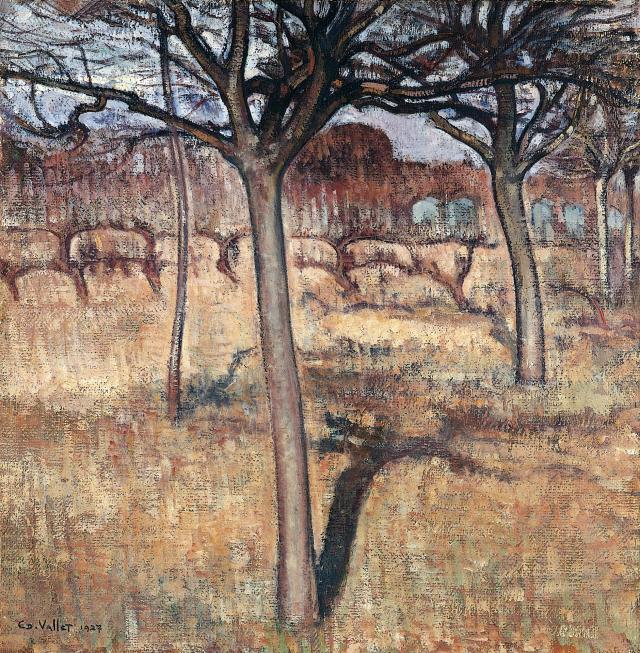Throughout his life, Édouard Vallet transcribed in paint the places where he lived. First, Geneva, its urban hustle and bustle and surrounding countryside, and then Valais and its valleys and mountains. If his initial panoramas reflect a style stamped by Barthélemy Menn’s pleinairisme (working out-of-doors), his painting developed a more individual cast after his return from Italy and above all during his repeated contacts with Valais.
From the School of Geneva, Vallet took away the importance of working outside, a necessary element for a realistic understanding of nature. From the Academy, he retained the necessity of working with sketches. Eager to bring together harmony and balance in his compositions, Vallet did one preparatory sketch after another – some two thousand have been conserved at this time – before elaborating his canvases, which he would simplify and strip of all useless details.
These two views are variations on the same composition depicting the trees of his orchard in Cressy, near Geneva. Petit paysage (Small Landscape) conjures up the autumnal brilliance of a colourful late-summer day whilst Le Verger en mars (The Orchard in March), painted one year later, returns to the same subject in its wintry embodiment with a light that seems to herald spring.
In each of the paintings, isolated trees stand in the foreground of a grove, their shadows similarly extending over the ground. Vallet plays on the effects of the two different seasons in a symbolic representation of nature’s cycles. In the one case, earthy colours and, in the other, vivid shimmering hues express the infinite mutations of the vegetation over time.In his arrangement of the trees, the artist creates a poetic geometry that stresses the repetition of the same motifs. He brings out the twisting lines of a nature that is embodied in tawny undergrowth, in trees with soaring outlines, in the undulations of shadows. Finally, the trunks circled by dark lines serve to remind us that the engraver behind the painter never stopped turning out prints of excellent quality.
From the School of Geneva, Vallet took away the importance of working outside, a necessary element for a realistic understanding of nature. From the Academy, he retained the necessity of working with sketches. Eager to bring together harmony and balance in his compositions, Vallet did one preparatory sketch after another – some two thousand have been conserved at this time – before elaborating his canvases, which he would simplify and strip of all useless details.
These two views are variations on the same composition depicting the trees of his orchard in Cressy, near Geneva. Petit paysage (Small Landscape) conjures up the autumnal brilliance of a colourful late-summer day whilst Le Verger en mars (The Orchard in March), painted one year later, returns to the same subject in its wintry embodiment with a light that seems to herald spring.
In each of the paintings, isolated trees stand in the foreground of a grove, their shadows similarly extending over the ground. Vallet plays on the effects of the two different seasons in a symbolic representation of nature’s cycles. In the one case, earthy colours and, in the other, vivid shimmering hues express the infinite mutations of the vegetation over time.In his arrangement of the trees, the artist creates a poetic geometry that stresses the repetition of the same motifs. He brings out the twisting lines of a nature that is embodied in tawny undergrowth, in trees with soaring outlines, in the undulations of shadows. Finally, the trunks circled by dark lines serve to remind us that the engraver behind the painter never stopped turning out prints of excellent quality.
